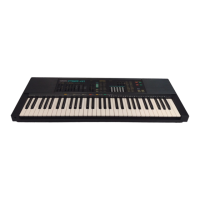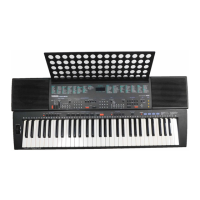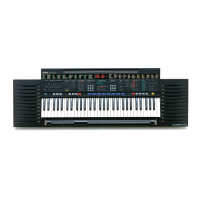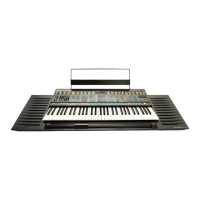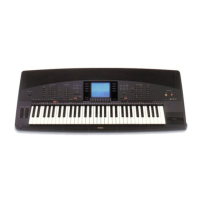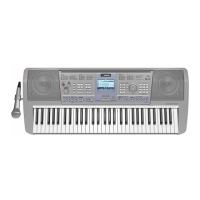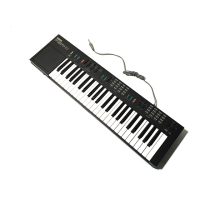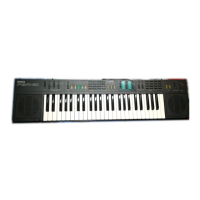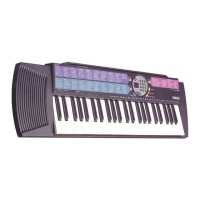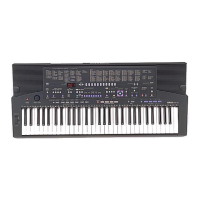
Do you have a question about the Yamaha Portatone PSR-410 and is the answer not in the manual?
| main amplifiers power (AC adaptor) | 4.5W x 2 |
|---|---|
| main amplifiers power (batteries) | 1.5W x 2 |
| rated voltage | DC 10-12V |
| battery type | Six SUM-1, “D” size, R-20 or equivalent |
|---|---|
| headphones/aux out impedance | 75Ω |
| speaker size | 12cm x 2 |
|---|
| weight | 6.0 kg |
|---|---|
| dimensions | 939mm x 397mm x 113mm |
Information contained in this manual is believed to be correct at the time of printing, but may be modified.
Service charges incurred due to lack of knowledge about functions are owner's responsibility.
Yamaha strives to produce user-safe and environmentally friendly products.
Details about the location of the name plate for recording purchase information.
Information regarding FCC compliance and potential interference with electronic devices.
Identification and page references for the main controls on the top panel.
Parameters that apply to the overall sound of the PSR-410, such as tempo and tuning.
Controls related to MIDI communication, including receive and transmit channels.
Controls for activating and managing the auto accompaniment feature.
Buttons for controlling the flow of accompaniment, such as start/stop and fills.
Controls for selecting and adjusting instrument voices and related parameters.
Ports for connecting MIDI devices for data exchange and control.
Connection for an optional sustain footswitch.
Output jack for private practice or connecting to external sound systems.
Power input jack for connecting an AC power adaptor.
Advice on avoiding conditions that can cause deformation or damage to the instrument.
Instructions for safe and proper use of the power supply and AC adaptor.
Recommendations for safe handling and transport to prevent damage.
Methods for cleaning the instrument's cabinet and panel.
Warning against user servicing and advice to refer to qualified personnel.
Details on using an AC power adaptor or batteries for instrument operation.
How to connect headphones or an external sound system for playback.
Information on connecting and using the sustain pedal.
Instructions for attaching the music stand to the instrument.
Steps to turn on the power and set the master volume for demo playback.
How to choose specific demo songs or play them in sequence.
Instructions for initiating and ending the demonstration song playback.
How to select a function or parameter to edit.
Methods for adjusting parameter values using buttons or numeric entry.
Direct numeric entry for selecting values, including hundreds digits.
Confirmation procedures for operations that change settings or data.
Selecting how multiple voices are played simultaneously across the keyboard.
Playing two voices simultaneously across the entire keyboard.
Assigning different voices to the left and right sections of the keyboard.
Combinations of split and dual modes for complex voice arrangements.
Assigning any of the 128 voices to the four orchestration parts.
Individually setting the volume balance between orchestration parts.
Adjusting the octave of each part up or down by up to two octaves.
Setting the stereo (pan) position for each orchestration part.
Automatically adding harmony notes to a melody line.
Playing drum and percussion kits using the keyboard.
Using the pitch bend wheel and setting its range.
Controlling note sustain using the footswitch.
Setting the key that separates left and right hand parts.
Shifting the keyboard pitch up or down in semitone intervals.
Tuning the pitch to match other instruments over a ±50-cent range.
Turning the keyboard's touch sensitivity on or off.
Choosing from 80 available accompaniment styles.
Defining the split point for auto accompaniment, separate from orchestration.
Selecting from 5 modes for how chords are interpreted for accompaniment.
Detailed explanation of Chord 1 mode for playing custom chords.
Adjusting the tempo for auto accompaniment, song memory, and multi pad playback.
Starting accompaniment immediately with the rhythm sound.
Visual indication of tempo and beat during accompaniment playback.
Starting accompaniment automatically when a note or chord is played.
Using Intro, Main A/B sections, and Fill-ins to control accompaniment flow.
Methods for stopping accompaniment, including using an ending pattern.
Adjusting the accompaniment volume relative to orchestration voices.
Controlling individual accompaniment tracks (Rhythm, Bass, Chords, etc.) in real-time.
Choosing a specific track to modify its assigned voice or parameters.
Adjusting voice, volume, pan, and octave for selected tracks.
Finalizing the re-voiced settings and confirming the changes.
Disengaging REVOICE to revert to the original accompaniment voices.
Storing voice and auto accompaniment settings into memory buttons.
Loading previously saved settings from registration memory.
Recording complete songs with accompaniment and melody tracks.
Recording short sequences, fills, or percussion sounds for multi pads.
Details on the ACCOMP and MELODY tracks and PAGE MEMORY storage.
Choosing the memory location to save the recorded accompaniment.
Choosing the appropriate style and fingering mode for recording.
Preparing the instrument to record the accompaniment track.
How to begin recording the accompaniment track by playing chords.
Methods for ending the recording process for the accompaniment.
Choosing a voice and setting parameters for recording the melody.
Preparing to record the melody track, disabling auto accompaniment.
How to start and stop recording the melody track.
Playing back recorded songs, individually or together.
Resets playback or recording to the first measure of a song.
Starting playback or recording from a specific measure number.
Description of multi pads, including chord match types.
Steps to record sequences, fills, or percussion sounds onto multi pads.
Playing back recorded multi pad data and creating effects.
Erasing data from a specific measure to the end of a song memory track.
Erasing all data from a specified multi pad.
Choosing between the four PAGE MEMORY locations for data storage.
Confirming the selection of a PAGE MEMORY location.
Details on MIDI ports and simple control using external keyboards.
Using external sequencers for more sophisticated MIDI recording.
Transmitting large amounts of MIDI data between devices.
Copying the entire contents of one PAGE MEMORY to another.
Setting reception modes for MIDI channels to control the PSR-410.
Configuring external MIDI clock and start/stop signals.
Assigning MIDI transmit channels for R ORCHESTRATION voices.
A comprehensive list of all 128 voices, their MIDI numbers, and polyphony.
A categorized list of the 80 available accompaniment styles with descriptions.
Restoring all page memory settings to factory defaults.
Resetting a specific page memory location to its initial values.
